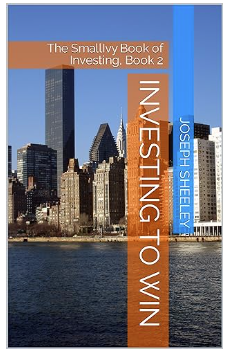
When you hear the word “budget,” you probably think of living in scarcity. But a budget is actually a powerful tool to help you live in great abundance. In this article we’ll discuss how to use a budget to determine your goals and grow wealth.
(Note, this site contains affiliate links. As an Amazon Associate I earn from qualifying purchases. When you click on an affiliate link and buy something, The Small Investor will get a small commission for the referral. You are charged nothing extra for the purchase. This helps keep The Small Investor going and free. I don’t recommend any products I do not fully support. If you would like to help but don’t see anything you need, feel free to visit Amazon through this link and buy whatever you wish. The Small Investor will get a small commission when you do, again at no cost to you.)
Why Use a Budget?
In The Key to Achieving Financial Freedom: Maximizing your Free Cash Flow the four principles of financial stability and freedom are discussed. these are:
- Create an income that exceeds your basic needs.
- Maximize your free cash flow.
- Use free cash flow to save up for things that you’ll need.
- Invest the excess and create a financial feedback loop.
Often people use a budget to reduce and then control their spending when they realize they’re in trouble financially. Preparing a budget can also help you figure out how much you can save and still pay for everything you need. The Pay Yourself First method, where you save and invest before you do anything else, is a great way to hold yourself to a budget once you’re developed one and decided how much you are able to put away. You figure out how much you need to be putting away with a budget, then put that money away before you spend on other things.
But they are useful also to determine how much income you need to make to meet your basic needs and then have money to invest. Budgets allow you to figure out how much money you need for recurring necessities as well as be sure you’re planning for non-regular expenses and future needs. This is how you can determine a goal income: The income you’ll need to make to have money to invest. Unless you’re making at least this income, you’ll always find it difficult to invest.
Want to learn the secrets to investing and really turbocharge your returns? Check out the second book in The Small Investor series, Investing to Win. This book presents 40 years of investing experience. Someone starting with zero knowledge of investing and the stock market could take this book and learn all that they needed to invest and do well. It would also be useful to someone who has invested and traded stocks for a while but who is really not getting the kind of returns desired.

Investing to Win
Preparing a Useful Budget for Goal Setting
When preparing a budget for goal setting, you’re wanting to determine how much you need to pay for basic necessities and how much you need to pay for everything in your life. Knowing how much your basic necessities cost will tell you how much income you need to just get by. Knowing how much everything in your life costs – both needs and wants – will tell you how much income you need to be making to live the lifestyle you want. In addition, you should calculate your “free cash flow.” This is how much money you have after you pay for the things you are required to pay for – your obligations.
You can pull together a budget using one of the many apps or just pull out a sheet of paper and start writing things down. You can also use this free basic budget spreadsheet that we’ll use in this article. Just download a copy and change things to meet your needs.
The SmallIvy Book of Investing: Book1: Investing to Grow Wealthy

SmallIvy Book of Investing: Book1: Investing to Grow Wealthy
Start with Income
To start out, pull together your income. Here you’ll want both your average monthly income as well as your yearly income. Your average monthly income should just be from sources that you can rely on each month, such as salary from a job. Yearly income can include income from things like investments that will fluctuate. We’ll talk about why later in this article.
We’ll have a couple, Bob and Rachel, and develop their budget as an example. Let’s start with work income:
Work incomeMonthlyYearly
Bob’s Job$3,000$36,000
Rachel’s Job$2000$24,000
Totals$5,000$60,000
Let’s add side-hustle income. Let’s say Bob mows lawns on weekends. Because he only mows during the warmer five months, the yearly total isn’t just 12 times the monthly average.
ItemMonthlyYearly
Lawn Mowing$500$6,000
Totals$500$2500
Bob and Rachel also have a couple of bank accounts. Let’s add those:
Bank AccountsBalanceRateYearly Income
Account 150003%$150
Account 210001%$10
Total$160
Here for bank interest we didn’t include monthly amounts, although we could if the balances were constant and, therefore, predictable interest would be generated. Investments in general, however, can fluctuate from month-to-month, so instead of using monthly totals, we will use yearly totals and look at whole years. Let’s say they also invest in stocks in a brokerage account and have a rental home:
Investments – Stocks
BalanceYearly Rate of Return (Avg)Yearly Income (Avg)
Account 1$50,00012%$6,000
Account 2$30,00010%$3,000
Total$9,000
Rentals
RentYearly ExpensesYearly Net Income
Rental 1$800$3,000$6,600
Total$6,600

Adding all of the sources of income up, here’s what we have:
Regular monthly income: $5500 for 5 months, $5000 for the other 7 months. We’ll just ignore the side hustle income when looking at coverage for monthly expenses since it isn’t all year. Instead, we’ll direct it towards building up savings for months when expenses are higher.
Investment income: $15,760. This includes stock income, so the amount will fluctuate from year-to-year. This income should therefore be mainly seen as a way to add to investments, rather than pay for regular expenses. It can be used to pay for the big purchases that happen every so many years like car replacements.
Total yearly income: $78,260
Figure Out your Obligations
Next, we list all of our obligations. These are expenses we are required to pay. Examples are: Rent, car payments, phone plan bill, monthly renters insurance, and child support payments.
The reason obligations are separated out is that we do not have the ability to change them from month to month. We can get rid of obligations long-term. For example, we can pay off a car and then buy the next car with cash. But you really don’t have the ability to not pay an obligation or pay less. This makes them an important element of your budget. It also makes them things we want to reduce and eliminate as much as we can.
For Bob and Rachel, let’s say their obligations are as follows:
Obligations
ItemMonthlyYearly
Rent90010800
Home Insurance2002400
Renters Insurance50600
Car Insurance2002400
Car Payment5006000
Phone1201440
Internet901080
Totals$2,060$24,720
So, before the year even starts, about $25,000 of their income is already spoken for. The monthly amount is a little over $2000. The larger these numbers are, the more they will need to make in income to make any headway.
Before you can start investing, you need money to invest. Check out FIREd by Fifty: How to Create the Cash Flow You Need to Retire Early. You’ll learn how to control your cash flow so that you’ll have money to invest and grow wealth.

Next, Figure Your Necessity Spending
Necessities are things we need to live, but are not fixed costs like obligations. This means we can reduce or increase them as we wish. For example, we need food, but we can cook inexpensive meals at home or go out for a nice dinner at a restaurant. We need to spend something for these things, but can cut back when things get tough.
For Bob and Rachel, here’s their necessities:
Necessities
ItemMonthlyYearly
Groceries2002400
Electricity1001200
Gasoline3003600
Clothing4004800
Toiletries30360
Cleaning supplies50600
Basic yardcare items2002400
Childcare5006000
Heating gas/oil1501800
Water80960
School Supplies20240
Car maintenance3003600
Home maintenance1001200
Totals$2,430$29,160
You can probably look through this list and see things where they could save money. This is a good place to look if you find you are overspending in your budget.
Looking at Long-Term Necessities
Most people adjust their basic monthly spending instinctively to match their spending, but then see anything left over each month as free money to spend. The issue then is that they then need to do something like replace a car and find they don’t have any money to pay cash. They then take out a car payment, adding an obligation to their list, and reducing their free cash flow (more on free cash flow in the next section). This makes it less likely that they will have cash the next time they have a big expense.
Instead, you need to look ahead and be putting money away for these expenses. Note that this is the third of the four principles of financial stability and freedom: Save up for things that you will need. That way you can pay cash and save money while preserving your free cash flow. You can also invest the money while you’re saving up, adding to your income and increasing your free cash flow. So, it has a compounding effect to be taking care of these expenses.
To determine how much you need to be saving, just estimate what the expense will cost and how many years it will be before it is needed. Then, divide the expense by the number of years and then by 12 to get the amount per month. For example, if a new car will cost $20,000 and you’ll need it in five years, you need to be saving: $20,000/5/12 = $333.33 per month.
For Bob and Rachel, this is what they have:
Long-term Necessities
ItemMonthlyYearly
Retirement3003600
Replace car3003600
Water heater replacement1001200
Replace AC3003600
Replace roof2002400
Replace refrigerator3504200
Home remodels/upgrades2503000
Totals$1,800.00$21,600.00
As you can see, there is a substantial amount that they should be saving up each month to meet future needs. Retirement is at the top of the list. This is a need that will require a lot of money, but really isn’t that hard to be ready for if you start early and invest the money as you go. More on retirement investing can be found in A Simple Way to Invest your IRA.
If they are using the Pay-Yourself-First method, they should be putting $1800 away each month, probably $900 per paycheck if they have two checks per month. $300 per month should be going for retirement into an IRA or 401k. The rest of their money should go first into savings. Once the amount in savings gets large enough and there is enough cash to pay for normal things that come up during the year, it can then go into a brokerage account for investing.
(If you’d like to learn more about how to decide how much you should put in different types of assets, Sample Mutual Fund Portfolios gives lots of information and examples of how to make allocations for all sorts of different goals, including retirement.)

Looking at Luxuries
The final element is luxuries. These are things that we could do without. That doesn’t mean that they shouldn’t be bought. Life without luxuries is pretty dull. Luxuries make life fun. Still you don’t need them to keep breathing.
Here’s what Bob and Rachel have for luxuries:
Luxuries
ItemMonthlyYearly
Netflix25300
Newspaper subscription25300
Dinners out2002400
Entertainment3003600
Blow money5006000
Totals$1,050$12,600
Note that we have “blow money” as a category. This is cash that the couple has that they can spend on whatever they wish. They would each get $250 each month. It is best to give this out as cash each month to keep from spending more than you mean to on this.
Let’s Do the Analysis
Now that we’ve gotten the budget together, let’s do some analysis.
Spending totals for Bob and Rachel are as follows:
MonthlyYearly
Spending Total$7,340$88,080
Basic Spending Total$4,490$53,880
Basic + Future Needs Total$6,290$75,480
Basic + Luxuries$5,540$66,480
So, they would need $7340 each month to cover everything on their list. Remember that they only had between $5500 and $5000 each month, so there is an issue they will need to address.
Their basic spending is $4490 per month. This is the obligations plus the necessities, so, what they need each month to cover everything critical. This is less than their monthly income on all months, so they are able to cover the basics and have some money left over. Most people would get to this point and then blow the rest of their income, thinking that they were fine. This works until a big expense comes up.
Their basic needs plus future needs is $6290 per month. This exceeds their income, meaning they will need to raise their income to really get on good financial footing. Looking at basic needs plus luxuries (ignoring future needs) we see that they are right at their summer income levels. They will find they have just enough in the summer but can’t quite make it in the winter months. Their investments will help with the yearly totals on average, but will not produce reliably every year. They’ll probably feel better off on years when their investments grow than when they shrink or just stay the same. On the bad years they’ll think they need to “tighten the belt.”
We can do a bit of further analysis on these numbers:
Analysis
MonthlyYearly
Free Cash Flow$3,440$53,540
Basic Net Income$1,010$24,380
Net Income Before Luxuries-$790$2,780
Total Net Income-$1,840-$9,820
Their free cash flow is how much they have left after paying for all obligations. Again, we see that they have plenty left over each month, so their obligations aren’t too overbearing for their income level. On a yearly basis, which includes income from investments, they actually have about $53,500 in free cash flow.
After paying for necessities, they will average about $1000 each month. On a yearly basis, they have a little over $24,000 on average. This will help them save for things like retirement and big expenses in the future as long as they reinvest the money and let it grow. Looking at Net Income before Luxuries, however, we see that they don’t have enough to cover saving for these future expenses on an average month. They are about $790 short. They are therefore relying on investment income to cover savings for some of these expenses. They have about $2800 left over after expenses per year, further showing that investment income is helping them out.
Total net income is negative both monthly and annually when luxuries are included. This means that they will need to cut back on things or increase their income. If they are able to cut back for a time, their investments will increase, which will bring up their income and narrow the gap. This is why it is important to live small when you’re young while your investments build up. They will then help you cover things for the rest of your life and you’ll be able to expand your spending.
Have a question? Please leave it in a comment. Follow me on Twitter to get news about new articles and find out what I’m investing in. @SmalllIvy_SI
Disclaimer: This blog is not meant to give financial planning or tax advice. It gives general information on investment strategy, picking stocks, and generally managing money to build wealth. It is not a solicitation to buy or sell stocks or any security. Financial planning advice should be sought from a certified financial planner, which the author is not. Tax advice should be sought from a CPA. All investments involve risk and the reader as urged to consider risks carefully and seek the advice of experts if needed before investing.
